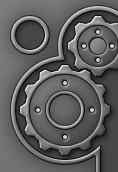Depending on the chosen speed, a regulated flow of steam is fed to the high-pressure slide valve. This is regulated by a throttle valve situated before the HP slide valve (here not visible). The cylinders are double acting, the slide valve allowing the high-pressure steam to act alternately on both faces of the piston. The slide valve passes the high-pressure steam to either side of the cylinder. The control rod for the valve is usually connected to a linkage attached to the crankshaft, so that the motion of the crankshaft also slides the valve. The expanded steam is then supplied to the next slide valve and the MP cylinder. Since this must produce the same power with reduced pressure, its diameter is substantially larger than that of its predecessor. The diameters of the cylinders of expansion engines are thus different. When the steam pressure is fully reduced by the LP cylinder, it is fed to a condenser. Here, the remaining steam is cooled and becomes water again, which after passing through a filter is pumped back to the boilers. The circulation of water is then completed.
The same linkage allows the engineer to put the engine into reverse rotation. The change to reverse rotation takes place through a connecting link, which brings all slide valves into an inverse position. This reversal is much faster than is possible with diesel engines.
|



